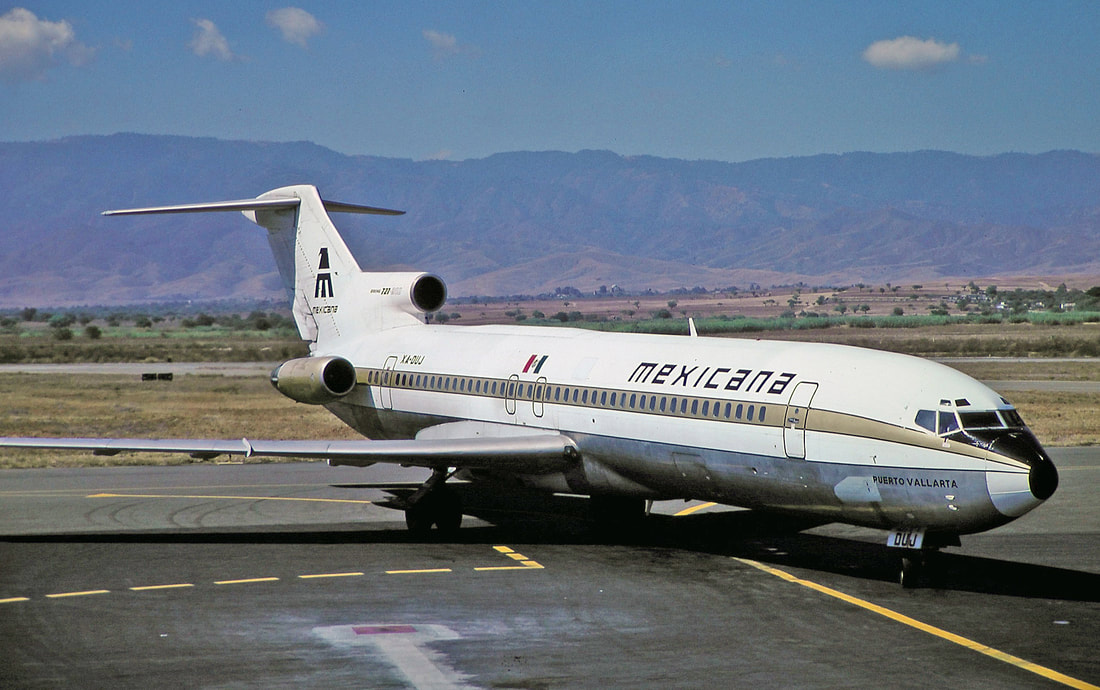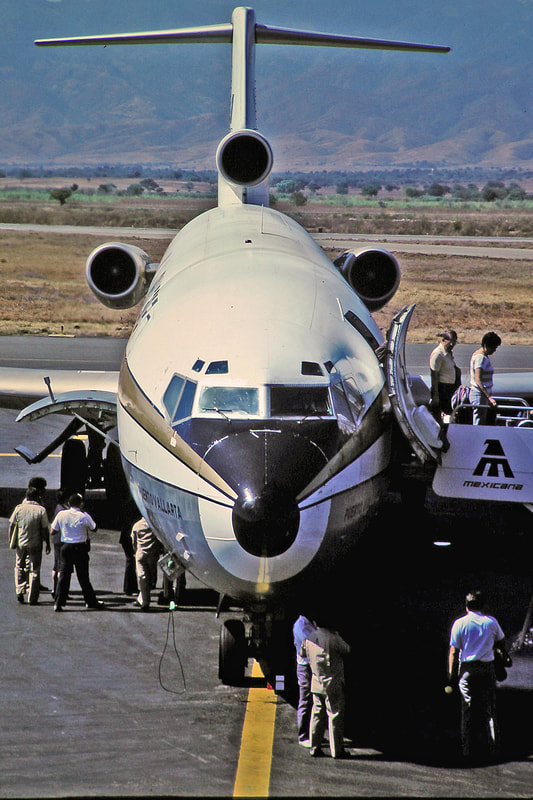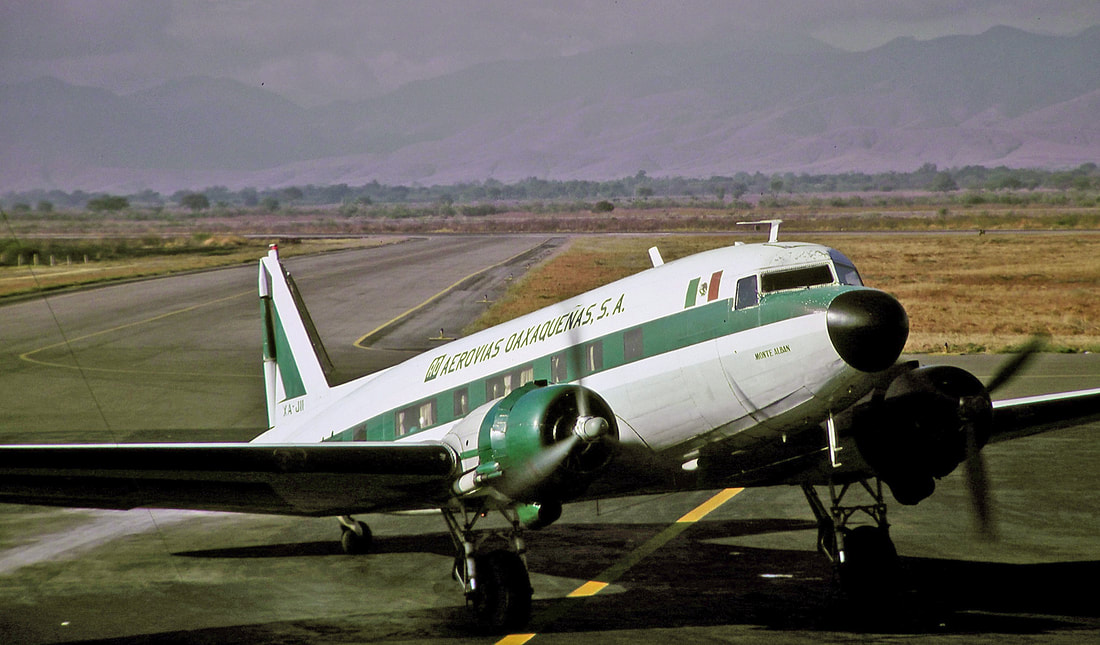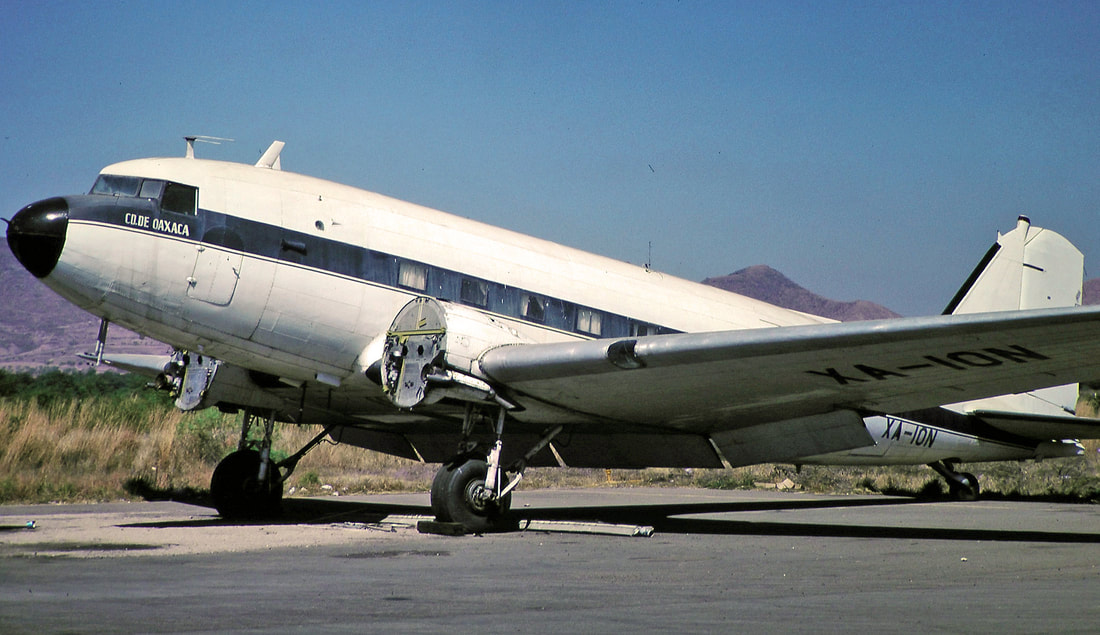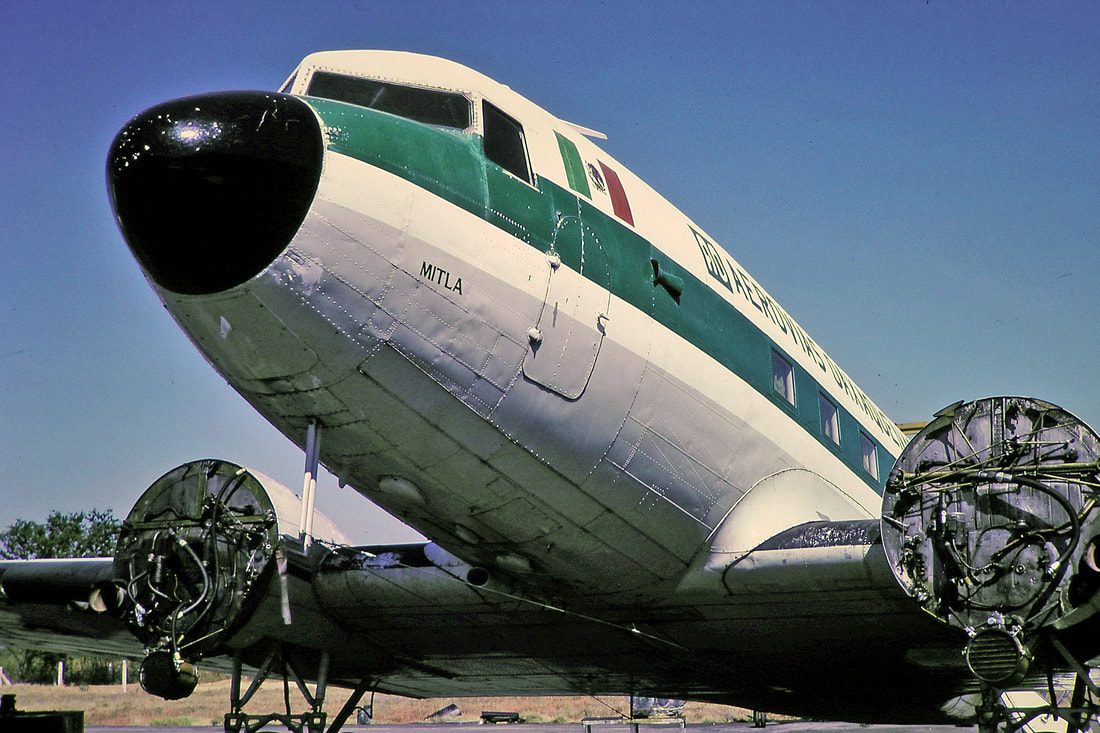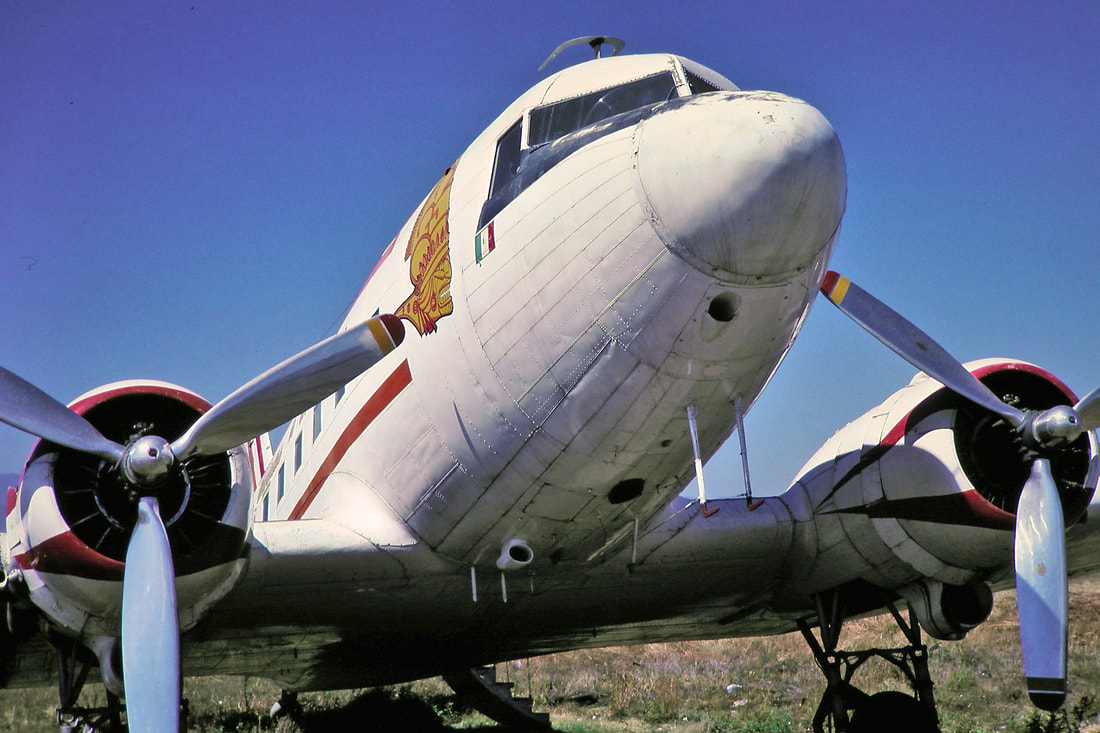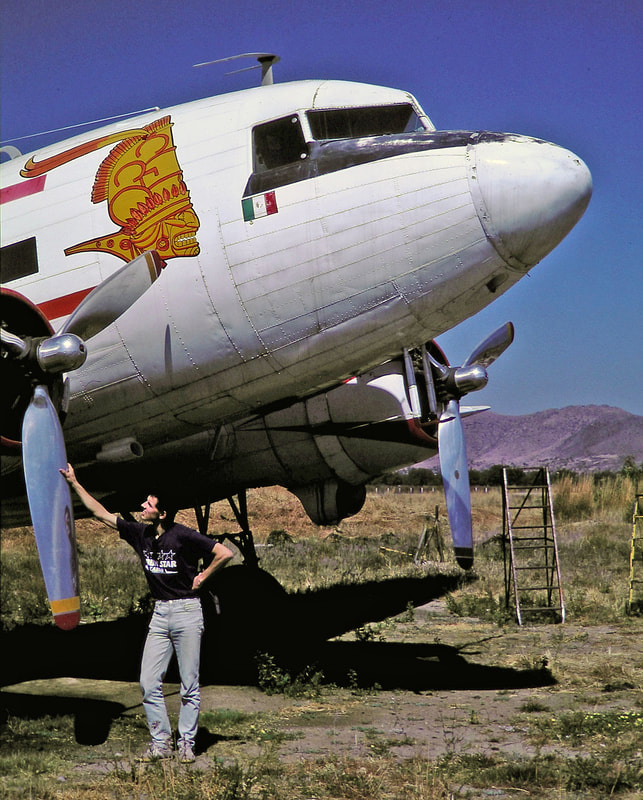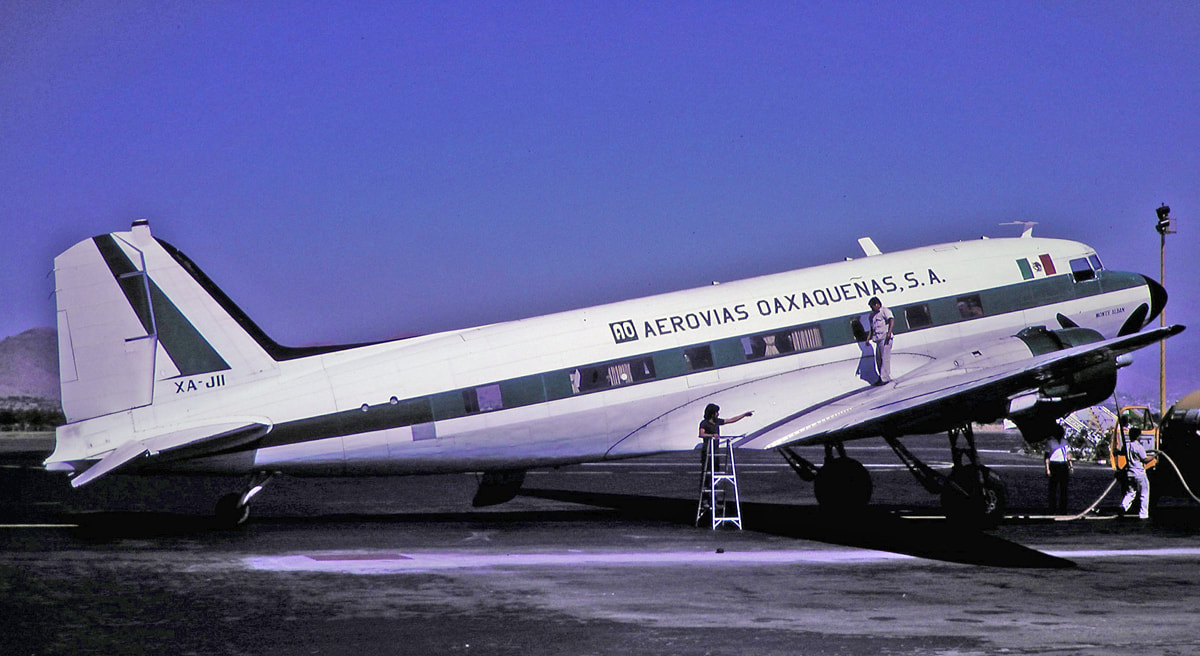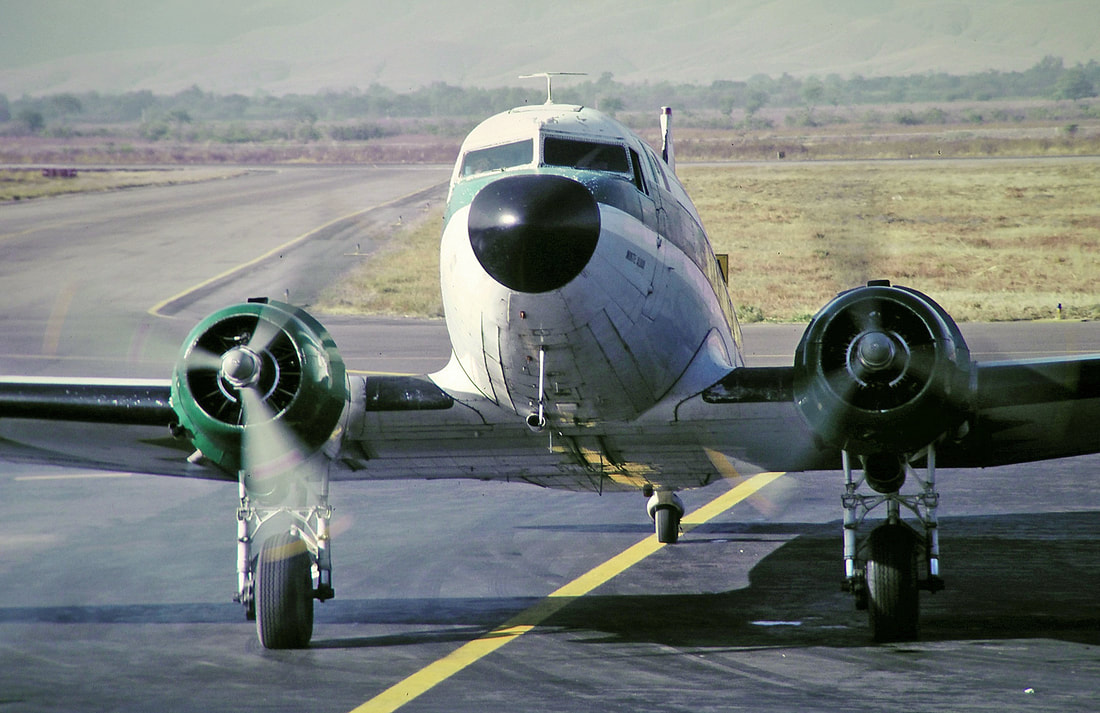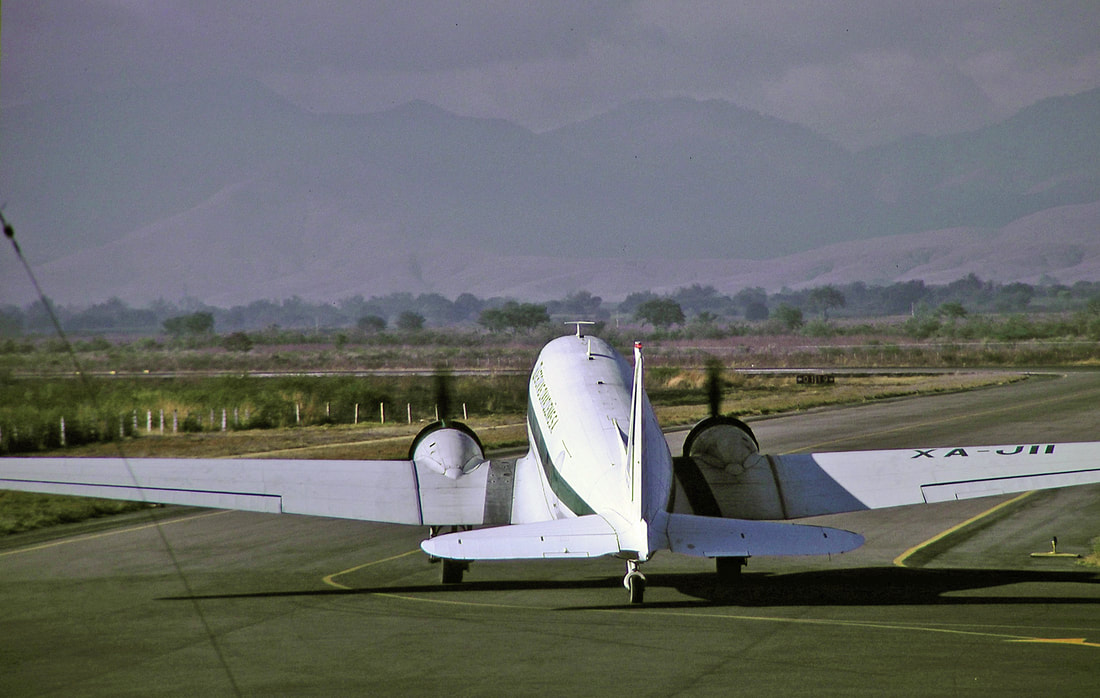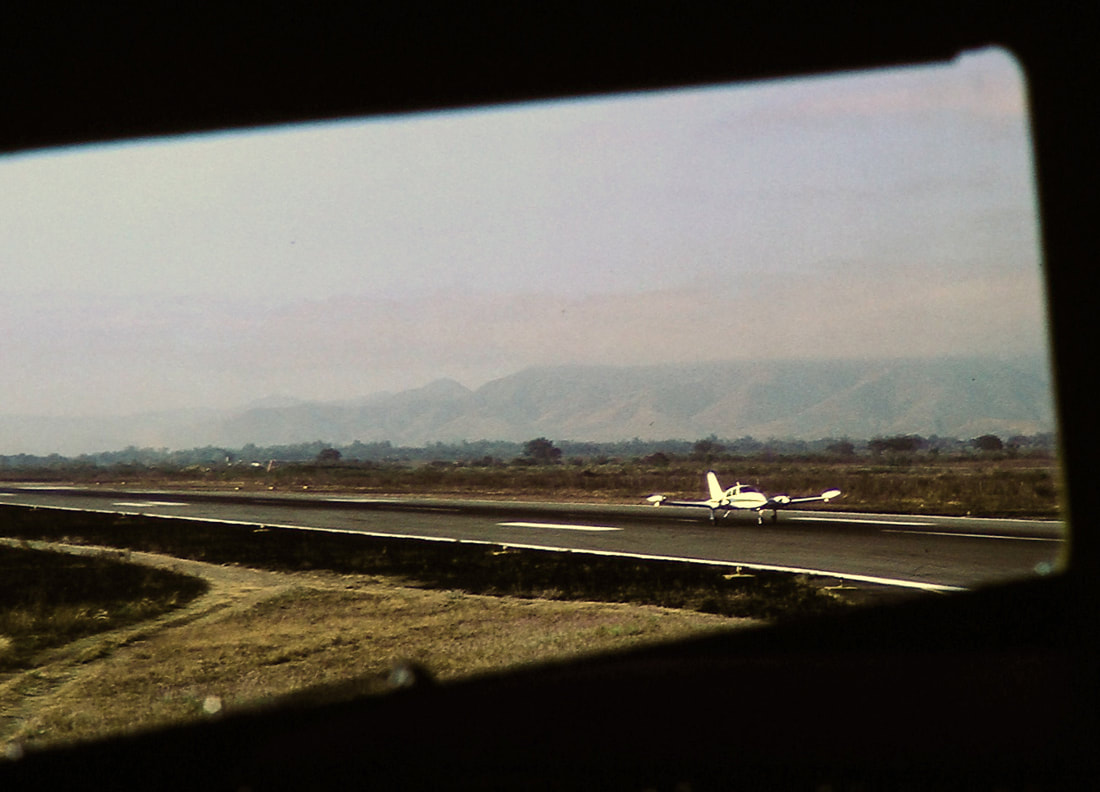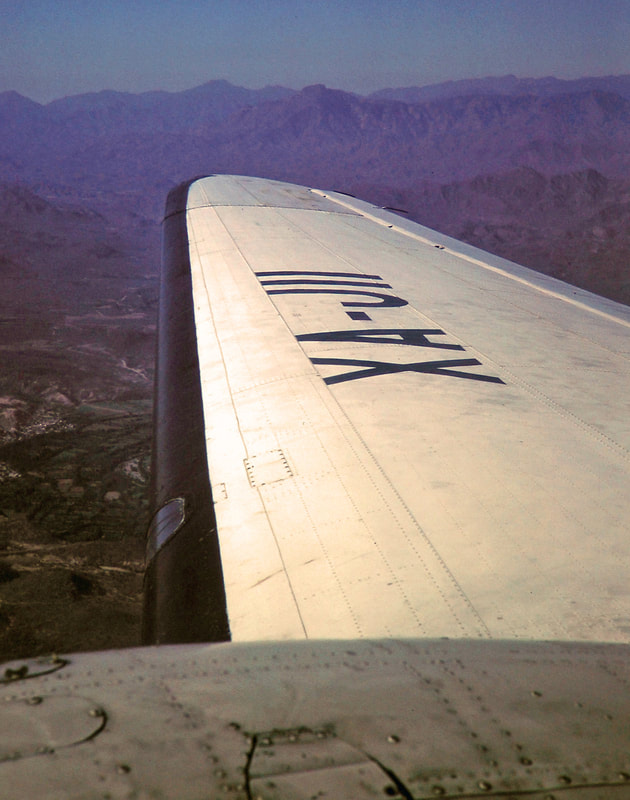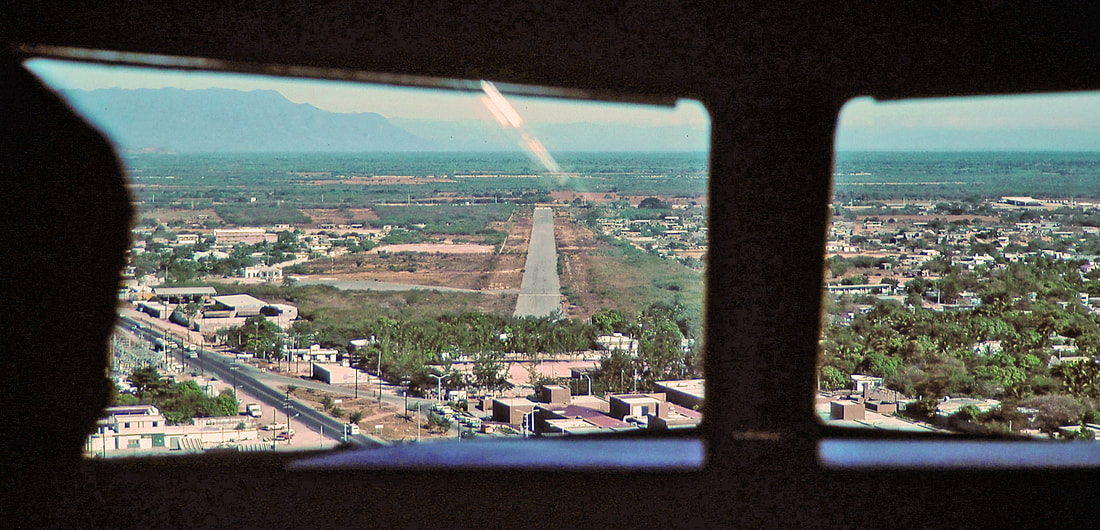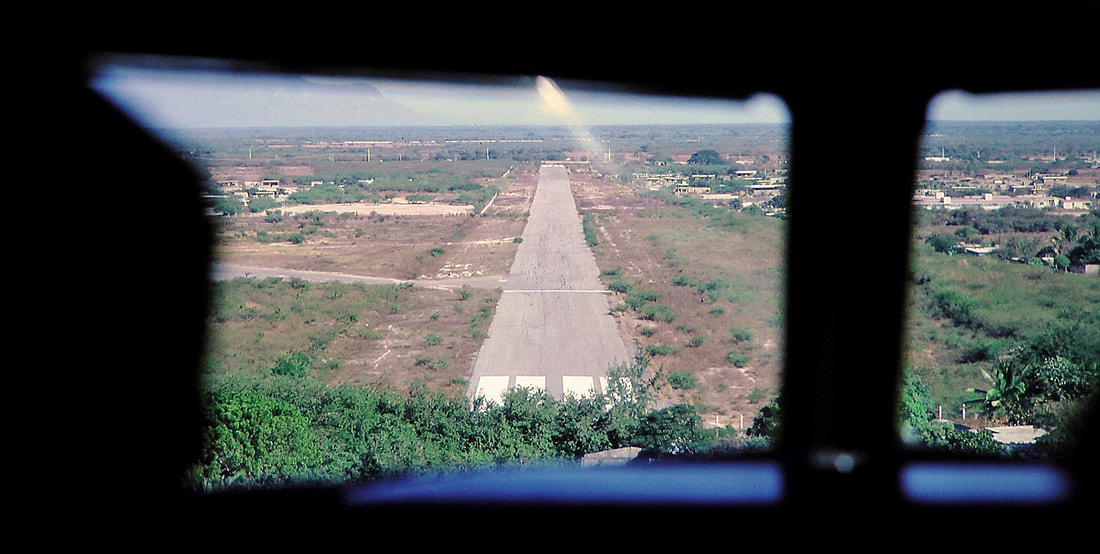Aerovias Oaxaquenas DC-3 to Salina Cruz, Mexico.
by Jan Koppen
In the winter of 1987, my girlfriend and I traveled by Cubana de Aviacion Ilyushin IL-62M CU-T1225 from Brussel to Havana, with stops in Zurich and Gandar (The latter only for uplifting fuel). After a stop-over in Havana, we traveled onboard a Cubana de Aviacion Tupolev Tu-154-B2 CU-T1222 to Mexico City. During our stay in Mexico, I took the opportunity to spend some time at Oaxaca Airport (460 km. south-west of Mexico City) to spot and photograph the Douglas DC-3 activity at this tiny airport. During these days, Kodachrome K64 was the norm for aviation slides, and for some reason, excessive use of the color blue was the favorite of Mr. George Eastman of Kodak! The quality output of my slides was meager, but nowadays, we have Photoshop, and with a lot of effort, I made the copy's presentable.
Enjoy the pics and captions.
Enjoy the pics and captions.
Here, Mexicana Airlines Boeing 727-200 'Puerto Vallarta' is caught between flights on a sticky day at Oaxaca airport in January 1987.
Boeing 727-200 XA-DUJ is seen here at Oaxaca shortly after arriving on a scheduled flight from Mexico City.
After Mexicana Airlines ceased operations, she was sold to DHL Venezuela and registrated YV-154T. In September 2010 the 727 was ferried to Orlando Sanford Airport, Florida for part-out & scrap.
Zorro-masked XA-SOE is seen here taxying in at Oaxaca against the backdrop of the Sierra Madre del Sur mountain range.
XA-SOE nosing-up to the camera on the ramp of Oaxaca airport.
A last look at Aeromexico XA-SOE as she climbs away from Oaxaca Airport, bound for Mexico City on January 18, 1987.
During the early 90's, she was ferried to Waco Connally Field, for part-out and scrap, which was completed on January 31, 1991.
Heat shimmers on an Oaxaca airport taxiway as Douglas DC-3 XA-JII crawls along, under the intense Mexican sunshine, in January 1987.
XA-JII "Monte Alban" in black & white! - Yes, during those days it was still common pratice to make black and white prints and develop them yourself.
Monte Alban. The city from which the ancient Zapotecs once ruled Oaxaca's Valles Centrales, towers 400m above the valley floor from a hilltop a few kilometers west of Oaxaca. This is one of Mexico's most culturally rich archaeological sites, with the remains of temples, palaces, tall stepped platforms, an observatory and a ball court all arranged in orderly fashion, with wonderful 360-degree views over the city, valleys and distant mountains.
With a midday temperature of 40 degrees centigrade, Aerovias Oaxaquenas Douglas DC-3 XA-JII is seen here arriving on here stand at Oaxaca on January 18, 1987.
Scattered around the ramp we discovered a variety of Dakotas.
After succesfully negotiating with the local airport authorities, we were fortunate enough to be granted permission to photograph the aircraft on the ramp. Through the sweltering morning heat, we made our way to the Dakota ramp, where a few minutes later we were able to view the familiar lines of the classic piston-engined veteran, the DC-3.
Another smart looking DC-3 resting on the baking ramp was XB-DPN. She carried some fantastic artwork on both sides of her fin, ressembling an Indian dancer. Her basically white fuselage was divede by some neat dark blue trim beneath her window line, and she carried the name 'Usila' under the cockpit windows.
XB-DPN was in active service, flying ad-hoc freight charters within Mexican skies, the majority of which consisted of uplifting loads of cement for the C.A.P.C.E. cement factory.
At the time of our visit we noticed that this DC-3 was undergoing some high level maintenance in the hands of the local engineers. One of these had slung his hammock between the undercarriage legs of the DC-3, and was enjoying the shade provided by the wings as he rested during his siesta!
Meticulous maintenance keeps ‘em flying.
Beautiful artwork adorns XB-DPN's ventral fin.
'Usila' with the love of my life.
Years later XB-DPN was seen derelict at Reynosa, Mexico.
We also discovered the engineless DC-3 XA-ION (c/n. 4425) wearing the name 'CD. de Oaxaca'. This former Spanish Air Force Dakota was delivered to Oaxaca-based Lineas Aereas Oaxaquenas S.A. a few years ago. Unfortunately, LAOSA ceased flying operatins some time ago, and subsequently the old Dakota has remained idle ever since.
CD. DE OAXACA stands for Ciudad de Oaxaca. The city and municipality of Oaxaca de Juárez or simply Oaxaca, is the capital and largest city of the eponymous Mexican state. It is located in the Centro District in the Central Valleys region of the state, on the foothills of the Sierra Madre at the base of the Cerro del Fortín extending to the banks of the Atoyac River.
The airplane's paint has faded extremely due to ultra—violet exposure.
DC-3 XA-ION remained stranded at Oaxaca and was seen there in a very derelict state many years later.
Another DC-3, which was undergoing a major overhaul, was XA-JIH (c/n. 9904) named 'Mitla'. Owned by operator Aerovias Oaxaquenas S.A., she once served as part of the large KLM Royal Dutch Airlines fleet. Both her engines had been removed and they lay scattered around the oil-stained ramp, which gave the ramp the impression of a deserted junk-yard.
Crying out for mechanical attention.
Well worn, XA-JIH "Mitla" exudes rugged dependability.
Ice, hail and rain have battered away the paint from the radome and the fuselage skin under the cockpit windows, making this workhorse look a little the worse for wear.
The Pratt & Whitney engines were sadly resting on some old worn aircraft tyres, but the Aerovias Oaxaquenas local duty officer assured us that the aircraft would be ready for duty the next day - we had our doubts about this remark!
Engineless and with paint fading, this forlorn Douglas DC-3 is seen gleaming on Oaxaca's apron on January 18, 1987.
A time capsule of aviation history.
XA-JIH is still sitting derelict at Oaxaca. Sometimes she is used by the airport staff for fire extinguishing purposes.
What a treasure.
Certainly the most handsome DC-3 was XA-JOI (c/n. 4992). This 1943 vintage fromer Trans Word Airliens DC-3 look to be in suprb condition and sported the very elegant white/red/orange livery of Aerolineas de Monte Alban, an airline which was named after the famous Monte Alban ruins. Located just aft of the cockpit window is a large decorative emblem which adorned both sides of the fuselage, symbolising a high priest of the Zapotec culture. Unfortunately, XA-JOI had but a brief career with Aerolineas de Monte Alban. The company was not able to pay her way and with debts mounting the DC-3 was impounded by the airport authorities.
During my visit she remained inactive lying in the long grass adjacent to the ramp, guarded by Mexican military police.
What a beautiful paint job.
Nose riding high, this DC-3 is seen here waiting things to come...but many years later she was still present in a sad state at Oaxaca airport.
Yours’s author, in those day still slim, posing in front of XA-JOI.
Note; - My Four Star Air Cargo T-shirt! A gift of my friend and DC-3 expert, Mr. Michael S. Prophet. I still have this shirt!
|
Aerovias Oaxaquenas, which was established in November 1979 by a group of local businessmen keen to make money, operated two 28-seat Dakotas for daily passenger schedules to the cities of Puerto Escondido and Salina Cruz. Purto Escondido, also known as the next Acapulco, is a tourist resort situated on a beautiful bay on the Pacific coast and can be reached by road from Oaxaca. However, in 1987, this entails a rather gruelling thirteen hour journey, partly along dirt roads and consequently air travel is definitely recommended. The other destination served by Aerovias Oaxaquenas is the airfield at Salina Cruz. This city is a booming and evil-smelling port with a navel base, extensive oil storage facilities and an oil refinery. Normally, only oil-workers and businessmen use the services of Aerovias on this route.
As we desired to depart from Oaxaca in grand style, we decided to sample a flight on one of Aerovias morning departures to Salina Cruz. We arrive at the airport at the crack of dawn, already the sun's rays were burning the skin and we proceeded to the Aerovias check-in desk, which was located inside the airport's ultra-modrn teminal buidling. Here we confirmed our two seats aboard flight number 104 to Salina Cruz. I introduced myself to the desk clerk as the "flying reporter from Holland who wished to ride the Mexican DC-3". A few minutes later I was introduced to the 43 year old captain, Jose Manuel Galicia Galan, who insisted that I remaind in the cockpit throughout our flight. Jose Manuel, who started flying at the age of 17, served as a Dakota pilot with the Fuerza Aerea de Mexico and amassed a grand total of 6,800 flying hours on a number of transport aircraft. Despite his other incredible achievements and his flying skills, he had not mastered the English language! His co-pilot, Gustano Ortego Berdeso, was also a DC-3 specialist with some 3,000 hours under his belt and he joined us a few minutes later. Berdeso had one advantage over his captain, he did speak some English, but 'yes' and 'no' were the only words I heard! Happily, my Spanish lessons paid off and so communication was no problem. |
Aerovias Oaxaquenas flight 104, from Oaxaca to Salina Cruz, of January 19, 1987, with a convenient ETD of 08:30LT. The price was only
26.873,00 pesos.
26.873,00 pesos.
Having been introduced to Berdeso, we made our way to the waiting DC-3 on the ramp. To my surprise, the DC-3 was not yet ready. A bright yellow fuel truck was still replenishing her tanks. Nobody seemed to be in any hurry despite her planned departure time of 08:30LT and we were then given a half hour delay.
Aerovias Oaxaquenas DC-3, XA-JII, tops up with oil and gasoline at Oaxaca.
"Rush hour" before flight departure.
Finally our 44 year old (in 1987) DC-3, which had been converted to executive configuration by Remmert Werner in 1963, was ready to allow her patiently waiting passengers to board.
Together with just six other passengers, we boarded XA-JII through the small door on the aft port side. Inside, we were pleasantly suprprised to find she still possessed a very luxurious interior. Comfortable, fresh green colored seats filled the cabin in a two-by-two layout. Located at the rear of the passenger cabin was a classic oak cloakroom with golden hangrips. The side and ceiling panels were decorate in a very stylish form and the interior lighting had been adapted to create a very special atmosphere. It seemed very hard to believe that I really was in a vintage airliner built during the 40's!
My girlfriend seated herself halfway along the aircraft, next to one of the panoramic window, thereby assuring herself of the best viewing point possible. I advanced forward to the flightdeck, where Captain Galan and co-pilot Berdeso were preparing the old bird for flight 104 to Salina Cruz. I was looking for the jump-seat, to prepare for take-off, but there wasn't one! Unlike most other DC-3's, XA-JII has a very spacious pantry area which is located just behind the cockpit with no bulkhead in between. So I was told to lean on the pantry!
At 09:05LT, the ground handler gave a 'thumbs-up' signal, indicating 'prop-clear'.
Soon afterwards both Pratt & Whitneys burst into life with a sudden jolt, generating a great deal smoke, only to be followed by a pleasant rumble as the engines gently warmed-up.
With 1200 hp of tired iron turning on either side, XA-JII 'Monte Alban' is held against the brakes.
Finally we turned away from the ramp.
Douglas DC-3 XA-JII 'Monte Alban' is seen here taxiing out for take-off at Oaxaca on January 19, 1987.
We had incoming traffic before it was our turn to depart.
At 09:15LT Captain Galan moved the throttle levers firmly forward and XA-JII thundered a purposeful way along the runway and lifted off in the clear morning air, to slimb slowly to our assigned altitude of 8,000 feet. I immediately noticed that I was in the company of a very professional flight-crew. With the greatest of ease they manipulated the controls and seemed to take it all in a very relaxed manner.
Captain Galan and his co-pilot were very interested in the aviation magazines that I had brought along and while studying them they did not seem to be too bothered about the mountain tops as they crept closely past! But I had a great degree of faith in the Mexican flight crew, who were performing a routine mission. During our conversation it became clear that they did not understand why anyone should be interested in old propller driven aircraft, let alone the faithful old DC-3.
After 50 minutes flying time we were approaching the outskirts of Salina Cruz and XA-JII began her descent with a wide left turn soaring over the Pacific Ocean.
Soon we were aligned on Salina Cruz's single 'runway' and during our final approach we passed low over the city center.
Aerovias Oaxaquenas 104 from Oaxaca, coming in nice and low over the piano keys.
Captain Galan placed his Dakota firmly onto the ground with a thud and we seemed to have arrived at what must be one of the most neglected airstrip in thew whole of Mexico. Thanks to some steady braking, our captain managed to stop the old DC-3 before disturbing a herd of very bedraggled looking goats that had strayed onto the airfield - a scene typical of everyday Mexican life!
We taxied to our parking position outside what appeared to be the remains of an old marine building. A few minutes later, our Captain shut down both engines and the door was opened. We both jumped out into some very thick, luscious vegetation and it seemed amazing that the old Dakota had actually managed to taxy through this growth at all!
Many years later XA-JII was permanently withdrawn from use at Puerto Esconida airport and is presently still there in a derelict state.
Once we had safely disembarked from the DC-3, we thanked Captian Galan and his co-pilot Berdeso for their hospitality and for providing such an enjoyable flight. From the airstrip we made our way to the public road and here we were soon picked-up by the local bus service which was operated by a most delapidated ancient charabanc, making us wish that we were back on board that old DC-3!
- The End -
